Primary Sump Pump Basics Revealed
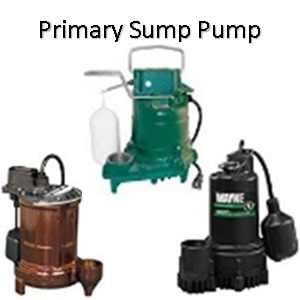 Primary Sump Pump Basics discuss floats, switches, pumping performance (GPH), pump housing, HP, cord length, basin size, continuous operation, electrical amps.
Primary Sump Pump Basics discuss floats, switches, pumping performance (GPH), pump housing, HP, cord length, basin size, continuous operation, electrical amps.
Understanding these primary sump pump basics with their features and how to use the basic information will enable you to purchase the best sump pump for your water pumping needs.
Read about primary sump pump basics on page below. See all topics by scollring down the page or using the topics button to select a specific topic.
The primary sump pump is given its name because it is the main sump pump in any house. Its motor is run by electrical power that pumps water from a container most commonly known as a sump basin. It relies on a float or electronic sensor to activate the switch to run the motor which pumps the water away from the house and thus protects the foundation and prevents basement flooding.
Primary Sump Pump Features
Each of the primary sump pumps features play a key role in its smooth operation so that’s why each of its features: floats, switches, pumping performance (GPH), pump housing, HP, cord length, basin size, continuous operation, electrical amps are discussed in detail below.
Floats
 When it comes to floats there are two types and a third type that assumes the role of a float. The two float types are tether and vertical. The type that assumes the role of a float are the diaphragm and an electronic sensor. The float responds to water height and at a predefined height or pressure causes the switch to send electrical current to the pump motor which runs until the water recedes and its pressure lowers enough to disengage the switch and stop the electrical current to the pump. If the motor fails to run because of float failure, basement flooding can occur. Because non electronic operated floats are mechanical they eventually wear out. This is why electronic control is becoming the preferred float type.
When it comes to floats there are two types and a third type that assumes the role of a float. The two float types are tether and vertical. The type that assumes the role of a float are the diaphragm and an electronic sensor. The float responds to water height and at a predefined height or pressure causes the switch to send electrical current to the pump motor which runs until the water recedes and its pressure lowers enough to disengage the switch and stop the electrical current to the pump. If the motor fails to run because of float failure, basement flooding can occur. Because non electronic operated floats are mechanical they eventually wear out. This is why electronic control is becoming the preferred float type.
Tether Float
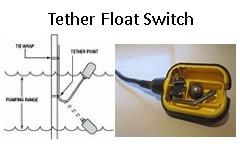 The tether float is comprised of a tether (long cord with an electrical current running through it) with a ball like float at the end. A switch is enclosed within the float. When the water recedes the float hangs beside the pump. As the water rises the float rises and the cord freely floats upwards. Eventually the float raises high enough for the switch in the float to engage causing the pump motor to run. As the water recedes the float and cord lower which causes the switch to disengage and the pump shuts off. The free movement of the tether float is concerning because it can easily get caught on something in the basin or on the side. However its long tether, allows the pump to run longer which helps prevent motor short cycle. On the other hand its length requires more basin width. This float type is not as popular as it once was because there are better options.
The tether float is comprised of a tether (long cord with an electrical current running through it) with a ball like float at the end. A switch is enclosed within the float. When the water recedes the float hangs beside the pump. As the water rises the float rises and the cord freely floats upwards. Eventually the float raises high enough for the switch in the float to engage causing the pump motor to run. As the water recedes the float and cord lower which causes the switch to disengage and the pump shuts off. The free movement of the tether float is concerning because it can easily get caught on something in the basin or on the side. However its long tether, allows the pump to run longer which helps prevent motor short cycle. On the other hand its length requires more basin width. This float type is not as popular as it once was because there are better options.
See A Tether Float Switch In Action
<
Vertical Float
 The vertical float includes a vertical rod and a float. The rod is attached at the top in the pump head where the switch resides and runs vertically parallel to the side of the pump. The float moves freely up and down the rod as the water rises and lowers. The distance the float travels the rod is preset by the manufacturer and cannot be altered like the tether float. Not all vertical floats look the same. Some have rods with an arm that holds both the bottom and top secure; while others have only a top arm. Those with two arms are more secure and free from basin hang up. The size and shape of the float varies. Some are large and oblong. Others are small circular disks. The vertical float is designed to decrease basin wall hang up because it has limited up and down movement unlike the tether float which moves horizontally and vertically. To protect the vertical float to an ever greater extent, some manufacturers use a top guard which makes it virtually impossible for the float to touch the basin wall during its movement.
The vertical float includes a vertical rod and a float. The rod is attached at the top in the pump head where the switch resides and runs vertically parallel to the side of the pump. The float moves freely up and down the rod as the water rises and lowers. The distance the float travels the rod is preset by the manufacturer and cannot be altered like the tether float. Not all vertical floats look the same. Some have rods with an arm that holds both the bottom and top secure; while others have only a top arm. Those with two arms are more secure and free from basin hang up. The size and shape of the float varies. Some are large and oblong. Others are small circular disks. The vertical float is designed to decrease basin wall hang up because it has limited up and down movement unlike the tether float which moves horizontally and vertically. To protect the vertical float to an ever greater extent, some manufacturers use a top guard which makes it virtually impossible for the float to touch the basin wall during its movement.
See A Vertical Float Switch In Action
Diaphragm
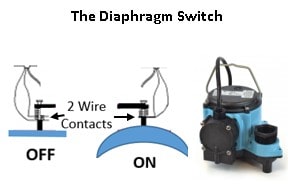 A diaphragm uses no float, tether or rod. Instead it uses a membrane which is attached to a drum shaped frame on the side of the pump. The membrane compresses under high water levels because of the greater water pressure. The membrane compression presses against the switch closing the electric circuit and turning the pump on. Eventually the membrane wears out and the pump fails.
A diaphragm uses no float, tether or rod. Instead it uses a membrane which is attached to a drum shaped frame on the side of the pump. The membrane compresses under high water levels because of the greater water pressure. The membrane compression presses against the switch closing the electric circuit and turning the pump on. Eventually the membrane wears out and the pump fails.
See The Diaphragm Switch In Action
No Float
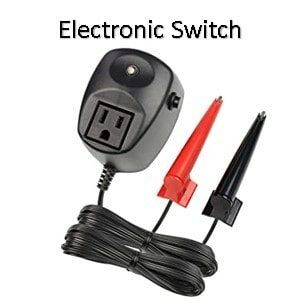 Since floats and diaphragms are mechanical and wear out over time, the no float option is becoming popular. The no float relies on electronics to sense water height and pressure through probes or a rectangular sensor that have no moving parts. This approach is very reliable. To date the no float device is solid state which means it is not an integrated part of the sump pump. It is attached independently to the discharge piping and must be used with a manual sump pump or one that has a piggyback plugin switch so the power cord can be plugged into the piggyback electronic switch plug.
Since floats and diaphragms are mechanical and wear out over time, the no float option is becoming popular. The no float relies on electronics to sense water height and pressure through probes or a rectangular sensor that have no moving parts. This approach is very reliable. To date the no float device is solid state which means it is not an integrated part of the sump pump. It is attached independently to the discharge piping and must be used with a manual sump pump or one that has a piggyback plugin switch so the power cord can be plugged into the piggyback electronic switch plug.
Switches
Several types of switches are used to complete the electric circuit so a sump pump runs. Some are dependent on the type of float used. We will discuss the different types below and how they work.
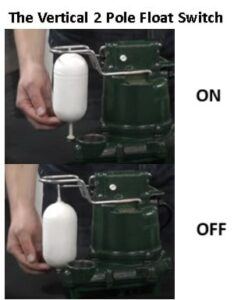 The Two-Pole Snap Action Switch
The Two-Pole Snap Action Switch
The two-pole snap action switch. common used by Zoeller, has two circuits which are open when the water is low. When the float rises with the water, the bottom circuit is closed first and at a predetermined height the top circuit closes at which time the pump runs. This Two-Pole Snap Action Switch has been in operation for many years. But it is mechanical and eventually fails.
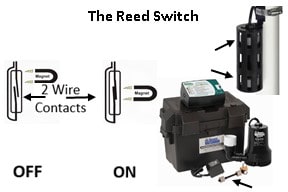 The Reed Switch
The Reed Switch
The reed switch, commonly used in Wayne, Liberty, Superior, and Glentronics, is comprised of a magnetic field with a magnet in the float and another one in the switch. The magnets are drawn to each other and attach when the float magnet rises to the predefined height set by the manufacturer and is within the magnetic field of the switch. As the magnets attach, the switch circuits close and electric current runs the pump. As the water lowers the magnets disengage and the electric circuit is opened and the pump stops. This switch type has been in operation for many years. But the Reed Switch too is mechanical and in hard water areas, corrosion builds up on the float magnet connection and causes failure.
The Rocker Switch
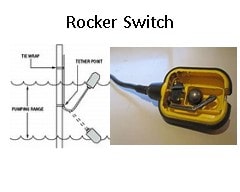 The rocker switch, commonly used in the tether float, is comprised of an internal ball which moves as a result of gravity. The steel ball located inside the float rolls towards the internal lever as the water rises. Eventually the ball reaches the lever and pushes it. When the lever is pushed, the switch is also pushed which completes the circuit and turns the pump on. When the water recedes, the steel ball rolls away and the connection is opened and the pump stops. The Rocker Switch is mechanical and over time the tether housing the electrical cord gets old and cracks causing electrical failure.
The rocker switch, commonly used in the tether float, is comprised of an internal ball which moves as a result of gravity. The steel ball located inside the float rolls towards the internal lever as the water rises. Eventually the ball reaches the lever and pushes it. When the lever is pushed, the switch is also pushed which completes the circuit and turns the pump on. When the water recedes, the steel ball rolls away and the connection is opened and the pump stops. The Rocker Switch is mechanical and over time the tether housing the electrical cord gets old and cracks causing electrical failure.
The Diaphragm Switch
 The diaphragm switch, commonly used by Little Giant, relies on water pressure to compress the diaphragm and press and activate the switch. Eventually build up in its air hole required for operating the pump can become clogged with debris and the thin diaphragm looses its capability to compress causing the pump to fail.
The diaphragm switch, commonly used by Little Giant, relies on water pressure to compress the diaphragm and press and activate the switch. Eventually build up in its air hole required for operating the pump can become clogged with debris and the thin diaphragm looses its capability to compress causing the pump to fail.
The Electronic Switch
The usage of electronics to sense water height and pressure eliminates the need of a moving float or diaphragm membrane. A sensing device is attached to the basins discharge piping system which sends signals to the electronic software programed chip residing in a switch which is plugged into an electric outlet. The electronic chip receives a signal when the water level reaches the low level indicator and when the water level reaches the high water level indicator. After receiving both the low and high level signal, the software chip signals the electric circuit to turn the pump on. As the water level recedes, the programmed chip tells the electrical current to stop flowing and the pumps turns off.
See The Operational Difference Between The Traditional Float Switch And An Electronic Switch
Additional Switch Type Terminology
Integrated Switch
An integrated switch is a switch that is part of the sump pump. Its wiring is integrated with the control of the pumps operation.
Solid State Switch
A solid state switch is a switch that is not part of the sump pump. It is an external switch that controls the operation of the pump by plugging the pumps electrical cord into its piggy back switch.
Piggy Back Switch
 A piggy back switch is a switch type that uses two electric cords: one for the motor and the other for the float switch. The motor cord is plugged into the piggyback outlet on the backside of the switch and the switch cord is plugged in the electric wall outlet. The piggy back design is an excellent way to deal with float switch failure. The pump motor can be plugged directly into the wall outlet and run manually.
A piggy back switch is a switch type that uses two electric cords: one for the motor and the other for the float switch. The motor cord is plugged into the piggyback outlet on the backside of the switch and the switch cord is plugged in the electric wall outlet. The piggy back design is an excellent way to deal with float switch failure. The pump motor can be plugged directly into the wall outlet and run manually.
Sump Basin
Sump pits, also known as sump basins, catch water draining into them from the outside drainage tile. Sump basins come in many shapes and sizes. A basin with an eighteen inch diameter is barely enough room for a primary pump and a battery backup pump to rest on the basin bottom next to reach other.
Horse Power
Horse power is the measurement used to define how much water a sump pump can pump in a specified period of time at a defined height. The most commonly used horse power is one-third. It can handle medium sized rainstorms by pumping around fifteen hundred to two thousand gallons of water per hour. One-half horse power can handle around thirty eight hundred gallon per hour pumping at a ten foot vertical height. A three-quarter horse power sump pump can handle round forty seven hundred gallons of water per hour. Installing the right size of horse power does matter. Too much horse power causes motor short cycling burn out and not enough horse power results in basin overflow. Be sure to measure the rate of water entering your pit during a heavy rainstorm so you can determine how much horse power is needed.
Pumping Performance
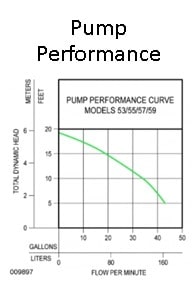 Pumping performance is defined as the rate at which water is pumped at a specific vertical height efficiently during continuous pumping. The lower the vertical height, the greater the pumping performance. The larger the motors horse power the greater its pumping performance. Manufacturers are required to test the pumping performance of each model and publish it because pumping performance is how the home owner can be sure to install the right sized sump pump.
Pumping performance is defined as the rate at which water is pumped at a specific vertical height efficiently during continuous pumping. The lower the vertical height, the greater the pumping performance. The larger the motors horse power the greater its pumping performance. Manufacturers are required to test the pumping performance of each model and publish it because pumping performance is how the home owner can be sure to install the right sized sump pump.
Pump Housing
 Pump housing is used to encase the motor and its other internal parts. The material used for pump housing is very important because not all materials dissipate motor heat well, keep their shape and avoid cracking. Thermoplastic housing is the cheapest material and least likely to dissipate heat but most likely to warp and crack; therefore it is best used when only low intermittent pumping is required. Bronze housing is the most expensive and durable material. It most effectively dissipates heat and does not crack or warp. Cast iron housing is similar to bronze in that it very effectively dissipates heat, will not crack or warp during continuous pumping; to combat its easy corrosion capabilities epoxy coating is used. Stainless steel housing is also used with greater horse powered pumps; to accommodate its lack of weight, a cast iron base is used. Aluminum and Zinc alloy is used for lower priced, lower horse power pumps. Aluminum and Zinc housing is better than thermoplastic but not as good as stainless steel, cast steel and cast iron.
Pump housing is used to encase the motor and its other internal parts. The material used for pump housing is very important because not all materials dissipate motor heat well, keep their shape and avoid cracking. Thermoplastic housing is the cheapest material and least likely to dissipate heat but most likely to warp and crack; therefore it is best used when only low intermittent pumping is required. Bronze housing is the most expensive and durable material. It most effectively dissipates heat and does not crack or warp. Cast iron housing is similar to bronze in that it very effectively dissipates heat, will not crack or warp during continuous pumping; to combat its easy corrosion capabilities epoxy coating is used. Stainless steel housing is also used with greater horse powered pumps; to accommodate its lack of weight, a cast iron base is used. Aluminum and Zinc alloy is used for lower priced, lower horse power pumps. Aluminum and Zinc housing is better than thermoplastic but not as good as stainless steel, cast steel and cast iron.
Motor Housing
Motor housing surrounds the motor and adds another layer for cooling. The material used for the housing makes a difference. Most pump manufacturers use canned motors made by a third party vendor who uses aluminum housing. Aluminum is not a good heat dissipater. Zoeller is the only manufacturer we know of that makes their own motors and houses them in cast iron. Cast iron is an excellent dissipater of heat. The more heat is drawn away from the motor the longer it will last.
Impeller
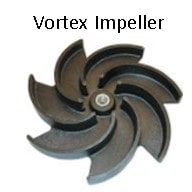 An impeller is a whirling disk shaped object placed in a sump pump to increase the velocity and pressure of the water so it leaves the pump faster. Its spinning action is slowed down by debris and small stones which clog and cause breakage. A broken impeller causes sump pump failure and a flooded basement. To prevent impeller failure manufacturers use various designs styles. Some of the design styles include: a vortex impeller for small solids flow through, a bottom screen to stop small pebbles from entering the impeller and top suction which leaves the stones on the basin bottom untouched. Each of these design styles works effectively so it is a matter of personal preference.
An impeller is a whirling disk shaped object placed in a sump pump to increase the velocity and pressure of the water so it leaves the pump faster. Its spinning action is slowed down by debris and small stones which clog and cause breakage. A broken impeller causes sump pump failure and a flooded basement. To prevent impeller failure manufacturers use various designs styles. Some of the design styles include: a vortex impeller for small solids flow through, a bottom screen to stop small pebbles from entering the impeller and top suction which leaves the stones on the basin bottom untouched. Each of these design styles works effectively so it is a matter of personal preference.
Power Cord
The power cord comes in various lengths. The shortest being 8 feet. Some can be customized up to 50 feet. It is important to buy the length needed because an extension cord should nob be used.
Electric Usage (AMPS)
AMPs indicates the amount of electricity use by the pump motor. The number of AMPs used varies from 6 to 12.
Primary Sump Pump Styles
The primary sump pump has two styles: the submersible and the pedestal or column. Both primary sump pump types have similar features but they look and work a little different.
The Pedestal Sump Pump
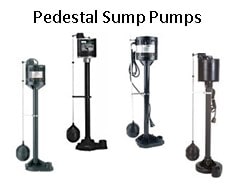 The pedestal pump has a long pole that sits in the water to act as a pedestal to hold the motor above water. It has a long suction tube to cause water to suck up through the discharge pipe and away from the house. The pump motor is always visible above the sump basin. Because the motor sits above the basin, its operation is noisier because the basin walls cannot absorb the motor sound. It can be a danger for pets and children because the motor is accessible at all times. However to perform maintenance the pump is easy to work with.
The pedestal pump has a long pole that sits in the water to act as a pedestal to hold the motor above water. It has a long suction tube to cause water to suck up through the discharge pipe and away from the house. The pump motor is always visible above the sump basin. Because the motor sits above the basin, its operation is noisier because the basin walls cannot absorb the motor sound. It can be a danger for pets and children because the motor is accessible at all times. However to perform maintenance the pump is easy to work with.
The Submersible Sump Pump
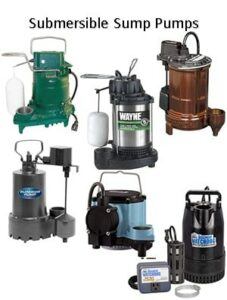 The submersible pump sits hidden in the basin under a cover. It can be completely submersed in water. Its base and impeller must sit in water at all times to prevent motor burn up. Because the motor sits in the basin, its operation is much quieter. The basin walls absorb the motor sound. It is safe for pets and children because the motor is hidden at all times and there are no visible moving parts. Pump maintenance is more difficult because it is necessary to remove the basin cover and disengage the discharge piping to remove the sump pump motor from the pit.
The submersible pump sits hidden in the basin under a cover. It can be completely submersed in water. Its base and impeller must sit in water at all times to prevent motor burn up. Because the motor sits in the basin, its operation is much quieter. The basin walls absorb the motor sound. It is safe for pets and children because the motor is hidden at all times and there are no visible moving parts. Pump maintenance is more difficult because it is necessary to remove the basin cover and disengage the discharge piping to remove the sump pump motor from the pit.
How To Use Sump Pump Basics To Select Best Sump Pump
Use the Basics to understand which primary sump pump is best for your water pumping needs.
SHOP THE SUMP PUMPS BELOW. Select Your Choice.
